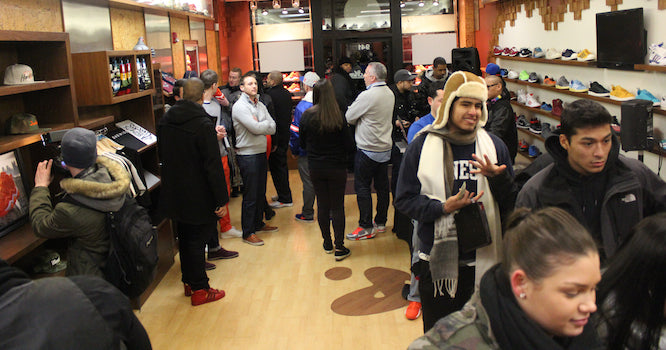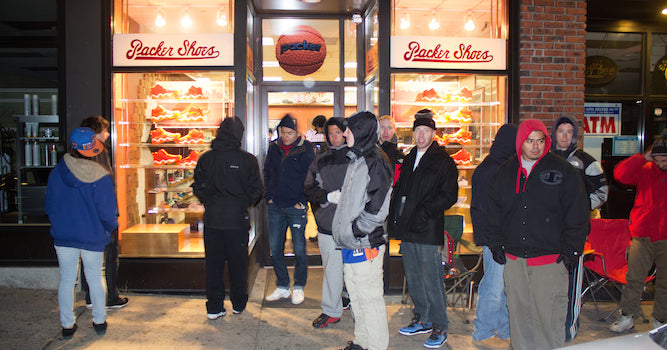Michael Packer, owner of Packer Shoes, knows a thing or two about sneakers. His family has been in the business for three generations. The original Packer Shoes store was started by his grandfather and great-uncle in Yonkers, New York in 1907.
A lot of things have changed since then, like the store's relocation to Teaneck, New Jersey, and the company's foray into ecommerce and omnichannel retailing, not to mention its budding clientele from around the world. But what hasn't changed is Packer Shoe's commitment to their community which now consists of "sneaker heads" – people who are so passionate about shoes they don't mind camping out overnight to get their hands on the latest and greatest pair.
With 107 years of history behind them, Packer Shoes continues to blend the old with the new, maintaining its heritage, while embracing the modern. Their non-traditional approach to offline and online marketing has allowed the company to adapt and thrive to this day.
In this success story, I catch up with Mike to get to know more about how he runs his retail business and successfully sells both online and offline.
1) Describe your business and products.
Packer Shoes is a family business that started back in 1907 by my grandfather and his brother, with the original store being based out of Yonkers, New York. It was your basic mom-and-pop heritage, all footwear and all ages across the board.
Sneakers were always at the very heart of the business and over time, it grew and we were fortunate enough to be one of Nike’s first accounts in the U.S., Adidas too, and then everyone else followed suit. The store that’s located in Teaneck, New Jersey now is an outgrowth of that first store, and this year will mark our 10th year at our current location.
2) You started with a physical retail store, when did you get going online?
We always were doing things online to a certain extent before, but it always felt backwards. In the beginning when we opened up something online it was basically having people emailing us about setting up all these PayPal invoices, and then we graduated to doing these mini-sites that were powered by PayPal, then trying different shopping carts before finally settling on Shopify.
We were also using another POS solution, but there was never anything that took it to the last leg of having everything under one umbrella and giving us the ability to manage all our inventory, both online and offline, in a single dashboard.
3) How did you go about picking your current location in Teaneck, New Jersey?

I’ve lived in Teaneck now for close to 20 years, it’s close to New York, in Bergen County. It’s suburban, but most of the people who are from around here, they’re shopping either locally or they’re going into New York. It’s very diverse and I don’t want to use the word “affluent,” but that's the key demographic. It’s no coincidence that the mall on Route 4, the Garden State Mall is one of the highest-grossing malls in the country. Even though it’s in New Jersey, you have mini-markets, you have every high-end shop in that strip of the highway. We’re not in a mall though, we're located in Teaneck.
When it comes to retail, generally your business depends on foot traffic. Which means you want to be centrally located. But when we opened in Teaneck, it was a real out-of-the-box idea of opening a sneaker store there, and had us questioning not only what we would do on the retail side but how we would do it.
At the end of the day though, if you have a product that people love, they will find you, and they will travel to get to you, so that’s something that we've been really grateful for from day one. Over the last 10 years, our following has grown and we've also been able to grow our presence on the web pretty substantially, allowing us to go from being just local, to national, to international now.
4) How did you go about deciding on the retail interior for Packer Shoes?

There's so much diversity in retail. I wouldn't be able to tell someone how to design a flower shop or something, but if you walk into our store, we still get this reaction to this day of people being like "whoa", thinking our store was out of place from where they would think a typical sneaker store like ours should be.
I think that’s the response that you want to have as a retailer about anything, because if you’re looking to differentiate yourself in any business, giving someone that feeling right off the bat is fantastic. There really isn't a better compliment that you can get from somebody then when they walk in and they can get a feel right off the bat for what your store’s about.
Now, there’s a lot of guys who work in the sphere that we’re in that are very creative and take different approaches to what they do, especially when it comes to designing their store. Everybody sets themselves apart in a certain way. But, I think what we do best and what we try and get across in everything that we do is taking a modern approach to a heritage-based business, and that's what keeps us honest to the Packer Shoes brand.
5) How does Packer Shoes market its brand?
I think we’re fortunate enough that when it comes to marketing, our focus is really on the sneakers and products themselves, so it's very much about the diversity amongst the brands that we carry and that focus does a great job of getting the word out for us. Another great thing about having relationships with the brands we carry is the ability of working with them on custom projects, in addition to the stuff that we're carrying for them.
Learn more: 10 omnichannel examples
Obviously we support the brands by working with them as far as getting stuff that would be right for the market, but when you do a special project with them, there’s a sort of cadence to doing it all. And when you put it out there for the world and you use social media and whatever else as far as non-corporate-type marketing goes, which is what works for us, you can accomplish a ton. That's when you have 10- to 50,000 people hitting your site at one time, going after a finite amount of shoes, which is why a backend platform (Shopify) that can support that becomes extremely important, because then everything goes smoothly without a glitch.
We’ve also never spent a dollar marketing ourselves or advertising ourselves in newspapers or magazines or anything like that. It has always been very non-traditional. People sometimes don’t understand it, but thankfully the product that we have, the word of mouth is very, very good for us. Especially social media. With a steady blog or Instagram feed, the feedback is just instantaneous. For example, we can literally put something up on Instagram and not two seconds later, the phone is ringing off the hook.
6) What are some advantages of selling both offline and online and how do you manage your operations?

The optimal thing, at least on our end, is to have everything under one roof because it’s a lot easier to manage the inventory. It's also easier to strategically allocate time and resources to both the online and physical retail stores. The last thing you want is to put up a shoe online over night and before someone can come in the next morning to get it, they're all gone.
Though it’s good that we can sell out of everything, at the end of the day, and maybe this is just a very old-school way of thinking, our customers, and our business is built on physical people walking into the store. That’s not something that we ever want to get away from.
I mean, the retail store is the face and the personality behind Packer Shoes. I can honestly say that if we were just online, we wouldn’t have the ability to do everything that we do project-wise or be able to work at the level we do with the big brands, because everything flows from our physical interaction.
I'm not going to say we sell the same products or amounts both online and offline, because we're looking at two different wants, but what I am saying is that if we're doing a special launch of an exclusive product, there's a percentage we're saving for our retail store. Because the last thing you want is for your inventory to be wiped out and 250 people sitting outside in the rain, snow, cold, heat, or whatever, and you get to number 15 and you're all sold out. That's just not the way to do business.
What advice would you give to online merchants thinking about selling offline?
I'd say the first and most important thing is to find a location that works for you and your brand. We got lucky because we were able to find something that is sort of a timeless piece of architecture in our current store, but we’ve tweaked it over the years, but that comes naturally with the growth of the business.
Secondly, you need to have a good team of people with you, and thankfully, I do. Guys who have been with me for years. Our current store manager for example started out shopping in the store when he was in high school just up the street. That morphed into him working part-time and now he’s been with me for seven years. Then there's the guys who work on the backend on the website and the retail store, it’s a great team that I have and the one thing I can say is if you are going from online to physical, it’s important to have everybody on the same page, all the time. If you don’t have all of that flowing together, things can get out of control quickly.
Lastly, I think the best advice I can give for anyone getting into physical retail is simply “expect the unexpected.”
P.S. Looking to get started selling offline? Check out Shopify POS.
Read more
- How PDPAOLA Improved Customer Lifetime Value by Unifying its Customer Data
- How Athleisure Brand Gym+Coffee Shifted to an Omnichannel Commerce Strategy in 2020 and Saw 350% YoY Growth
- How Earl of East Transformed a Foot Traffic Business Into a Digitally-Ready Brand
- How a San Francisco Indie Wine Store is Attracting International Customers
- Ultra Football Will Never Walk Alone with Shopify POS
- The Sheet Society Dreamed of Increasing Their Sales and Shopify was the Perfect Fit
- How This Canadian Footwear Brand Is Finding Success Focusing on Heritage and Style
- How Two Fashion Designers Used a Pop-Up Shop to Build Their Brand and Better Understand Their Customers
- How One Disruptive Menswear Brand Transformed a Pop-up Space in SoHo, NY





